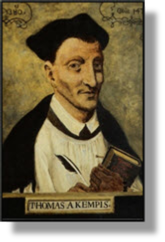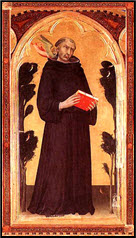


THOMAS À KEMPIS c1380 -
Including:
Gerhard
Groote

xxxxxThe German monk Thomas à Kempis spent most of his life at the monastery of Mount Saint Agnes at Zwolle in the Netherlands. It was here that he wrote The Imitation of Christ, a brilliant devotional treatise which incorporated the beliefs of the movement known as Devotio Moderna. These stressed the importance of the spiritual life over the materialistic, and the need to follow a life of humility and poverty. It was in circulation from around 1418
 xxxxxThomas à Kempis was born Thomas Hemerken and took his name from his birthplace, Kempen in the Rhineland. He was educated in the Netherlands at Deventer, a centre devoted to education and the care of the poor, and then joined the Windesheim congregation at the Augustinian monastery of Mount Saint Agnes at Zwolle. It was here, as a monk, that he spent most of his long life, mainly occupied in copying manuscripts and writing works of devotion.
xxxxxThomas à Kempis was born Thomas Hemerken and took his name from his birthplace, Kempen in the Rhineland. He was educated in the Netherlands at Deventer, a centre devoted to education and the care of the poor, and then joined the Windesheim congregation at the Augustinian monastery of Mount Saint Agnes at Zwolle. It was here, as a monk, that he spent most of his long life, mainly occupied in copying manuscripts and writing works of devotion.
xxxx xThe treatise De Imitatio Christi (The Imitation of Christ) is generally attributed to him and, if it is by his hand, then it is certainly his best work. Indeed, it is considered by many to be the most outstanding devotional treatise ever produced, and one of the most influential writings in Christian literature. Written in simple language and style, it incorporates the beliefs associated with the movement known as Devotio Moderna. It stresses, above all, the importance of the spiritual over the materialistic, and the need to be Christ-
xThe treatise De Imitatio Christi (The Imitation of Christ) is generally attributed to him and, if it is by his hand, then it is certainly his best work. Indeed, it is considered by many to be the most outstanding devotional treatise ever produced, and one of the most influential writings in Christian literature. Written in simple language and style, it incorporates the beliefs associated with the movement known as Devotio Moderna. It stresses, above all, the importance of the spiritual over the materialistic, and the need to be Christ-
 xxxxxThe movement Devotio Moderna (Modern Devotion) was a movement of spiritual reform created by the Dutch priest Gerhard Groote (1340-
xxxxxThe movement Devotio Moderna (Modern Devotion) was a movement of spiritual reform created by the Dutch priest Gerhard Groote (1340-



H5-
Acknowledgements
Thomas À Kempis: 1460, artist unknown. Gerhard Groote: by the Italian painter Simone Martini (c1284-